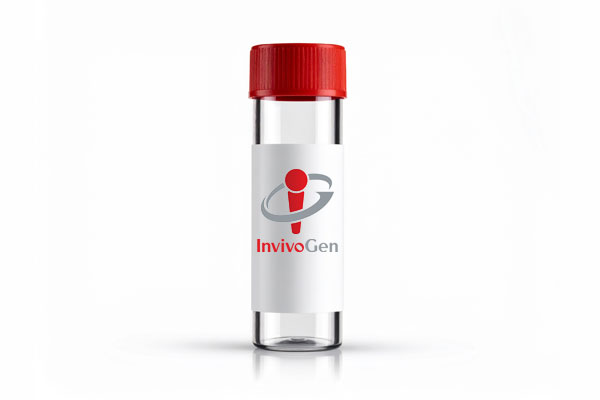
Anti-mTLR2-IgG
-
Cat.code:
mabg-mtlr2-2
- Documents
ABOUT
Murine TLR2 Detection and Neutralizing Antibody (clone C9A12) - Monoclonal Mouse IgG2a
Anti-mTLR2-IgG2a (clone C9A12) is a fully mouse monoclonal antibody specific for murine Toll-like receptor 2 (TLR2, CD282). This autoantibody was raised in mice by a proprietary method designed to induce the production of anti-TLR2 antibodies directly in the animal.
Anti-mTLR2-IgG has been selected for its ability to efficiently neutralize the biological activity of mTLR2. It can also be used to detect mTLR2 using flow cytometry. This antibody has been produced in hybridomas and purified by affinity chromatography.
TLR2 plays an essential role in detecting a diverse range of microbial pathogen-associated molecular patterns (PAMPs) [1]. An essential feature of TLR2 is its ability to form heterodimers with TLR1 and TLR6. TLR2 cooperates with TLR6 in response to diacylated mycoplasmal lipoproteins [2], and associates with TLR1 to recognize triacylated lipoproteins [3,4].
Key features:
- Reacts with murine TLR2
- Provided azide-free
- Each lot is functionally tested
References
1. Oliveira-Nascimento L. et al., 2012. The Role of TLR2 in Infection and Immunity. Front Immunol 3:79.
2. Girard R. et al., 2003. Lipopolysaccharides from Legionella and Rhizobium stimulate mouse bone marrow granulocytes via Toll-like receptor 2. J Cell Sci. 116:293-302.
3. Ozinsky A. et al., 2000. The repertoire for pattern recognition of pathogens by the innate immune system is defined by cooperation between toll-like receptors. PNAS USA. 97:13766-71.
4. Thakran S. et al., 2008. Identification of Francisella tularensis lipoproteins that stimulate the Toll-like receptor (TLR) 2/TLR1 heterodimer. J Biol Chem 283:3751-9.
All products are for research use only, and not for human or veterinary use.
SPECIFICATIONS
Specifications
Murine TLR2 (mTLR2)
Neutralization (tested), Flow cytometry (tested)
Each lot is functionally tested and validated.
CONTENTS
Contents
-
Product:Anti-mTLR2-IgG
-
Cat code:mabg-mtlr2-2
-
Quantity:2 x 100 µg
Shipping & Storage
- Shipping method: Room temperature
- Upon receipt, store at -20°C.
- Avoid repeated freeze-thaw cycles
Storage:
Caution:
Details
Toll-Like receptors (TLRs) play a critical role in early innate immunity to invading pathogens by sensing microorganisms. These evolutionarily conserved receptors recognize highly conserved structural motifs only expressed by microbial pathogens, called pathogen-associated microbial patterns (PAMPs). Stimulation of TLRs by PAMPs initiates a signaling cascade leading to the secretion of proinflammatory cytokines following NF-κB activation. To date ten human and twelve murine TLRs have been characterized, TLR1 to TLR10 in humans, TLR1 to TLR9, TLR11, TLR12 (aka TLR11), and TLR13 in mice, the homolog of TLR10 being a pseudogene.
TLR2 is involved in the recognition of a wide array of microbial molecules. TLR2 recognizes lipoteichoic acid and lipoprotein from gram-positive bacteria, lipoarabinomannan from mycobacteria, and zymosan from yeast cell wall. Moreover, TLR2 participates in the recognition of some types of LPS. TLR2 is known to heterodimerize with other TLRs, a property believed to extend the range of microbial molecules that TLR2 can recognize. TLR2 cooperates with TLR6 in response to diacylated mycoplasmal lipopeptides [1], and associates with TLR1 to recognize triacylated lipopeptides [2]. Furthermore, pathogen recognition by TLR2 is strongly enhanced by CD14 [3].
1. Girard R et al., 2003. Lipopolysaccharides from Legionella and Rhizobium stimulate mouse bone marrow granulocytes via Toll-like receptor 2. J Cell Sci. 116(Pt 2):293-302.
2. Ozinsky A. et al., 2000. The repertoire for pattern recognition of pathogens by the innate immune system is defined by cooperation between toll-like receptors. Proc Natl Acad Sci USA. 97(25):13766-71.
3. Lotz S. et al., 2004. Highly purified lipoteichoic acid activates neutrophil granulocytes and delays their spontaneous apoptosis via CD14 and TLR2. J Leukoc Biol. 75(3):467-77.
DOCUMENTS
Documents
Technical Data Sheet
Safety Data Sheet
Certificate of analysis
Need a CoA ?



